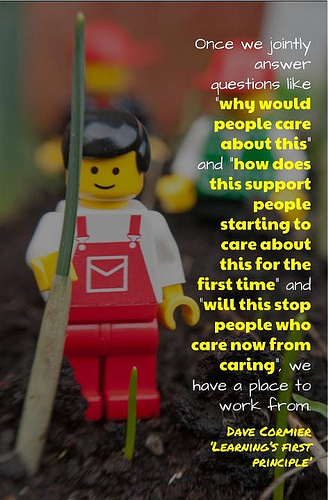
flickr photo shared by mrkrndvs under a Creative Commons ( BY-NC-SA ) license
In a post exploring the challenge of gathering different perspectives, Tom Barrett spoke about Thomas Edison’s practise of convening a creative council. A group of people who allowed Edison to ‘cast widely’ in order to accelerate creative connections. Reflecting on this, Barrett poses the idea of having our own ‘creative council’. Not necessarily a group of literal people, rather an imaginary group who you could turn to answer such questions as:
- What would…think?
- How would … approach this problem?
- What actions would … take next?
I have discussed the idea of turning to imaginary figures before. However, I had never really thought of a ‘set council’. What was interesting is that every time I started a list, I just felt that it did not have enough breadth either in time, experience or gender. I decided I needed a range of people including a religious figure, a scientist, an artist, a military strategist, a philosopher and a musician. Here then is my creative council, a group of people who I think would make for some interesting conversation:
- Nicolaus Copernicus: Let alone for his breadth of work and experience, Copernicus persisted a truth that lie outside the view of so many others, even with the consequences it might have.
- Wolfgang Amadeus Mozart: As much as I think that it would be interesting to have Richard D. James at a table, I wonder what Mozart could add to the discussion. Like Copernicus, Mozart’s ability to envisage new beginnings and possibilities always intrigues me.
- Jane Austen: I remember growing up with the BBC costume dramas, thinking I someone knew Jane Austen. However, like so many, I believe there is more than meets the eye with Jane Austen.
- Leonardo da Vinci: It seems so odd that we still talk about many of da Vinci’s ideas and innovations so long after the fact. He seemed to have a knack of seeing the new in every situation.
- Lao Tzu: I am neither sure that ‘Lao Tzu’ was a real person, not what he would add exactly, but I am sure the conversation would be better for it.
- Ludwig Wittgenstein: Unlike those who spend their whole life justifying their position, Wittgenstein seemed to continually start again. I think that the willingness to not hold tightly offers a lot.
- Hernán Cortés: Although I do not agree with anything that he did, I do think that anyone who is committed enough to burn his own boat certainly adds a different perspective.
Having thought about the real life influences on my thinking before, this was a different sort of task. I think that looking back over it, I feel it says so much about me and my thinking. Each of the people in their own way challenging conventions and breaking the mould. However, it also highlights many of many of my biases and prejudices. For one thing, whether intentional or incidental, many of the thinkers are male Europeans. Maybe this says a lot about my own background, I am not sure. I also feel that even though the different people represent various fields of work, they all seem a little bit similar, too familiar.
I wonder if such an activity is better suited within a context, a point that Barrett was trying to push towards in suggesting a ‘classroom’ creative council. For example, at Google Teacher’s Academy last year, it was often asked, “What would say or do Sergey Brin?” While maybe this might add a little more impetus to house systems, with those figureheads being seen more as a name. Allowing such questions as: “What would Fred Hollows think?” or “What would Caroline Chisholm have done?”
I also think that maybe the concept of a creative council is best thought of as an ever present growing organism with people coming and going. In his response, Bjorn Paige suggests that his PLN is his ‘creative council’.
For the times I need advice, consolation, or just an ear to hear, a constellation of educators fill my night sky, always pointing true north.
What about you? Who are those people, past and present, that you go to in your thinking? How do they push you deeper? What values do they espouse? Are there any biases? How do you challenge them? I know I have some work to do, more recruitment needed to be done. As always, feel free to share below.
If you enjoy what you read here, feel free to sign up for my monthly newsletter to catch up on all things learning, edtech and storytelling.















